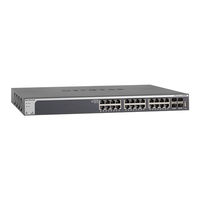NETGEAR ProSafe XS748T Manuals
Manuals and User Guides for NETGEAR ProSafe XS748T. We have 5 NETGEAR ProSafe XS748T manuals available for free PDF download: User Manual, Hardware Installation Manual, Installation, Installation Manual
NETGEAR ProSafe XS748T User Manual (373 pages)
28-Port and 48-Port 10-Gigabit Smart Managed Switch
Table of Contents
Advertisement
NETGEAR ProSafe XS748T User Manual (373 pages)
28-Port and 48-Port 10-Gigabit Smart Managed Switch
Table of Contents
NETGEAR ProSafe XS748T Hardware Installation Manual (31 pages)
ProSAFE 28-Port and 48-Port 10-Gigabit Smart Managed Switch
Table of Contents
Advertisement
NETGEAR ProSafe XS748T Installation (2 pages)
ProSAFE Smart Managed Switch
NETGEAR ProSafe XS748T Installation Manual (2 pages)
28-Port and 48 Port 10-Gigabit Copper Smart Managed Pro Switch with 4 SFP+ Ports




